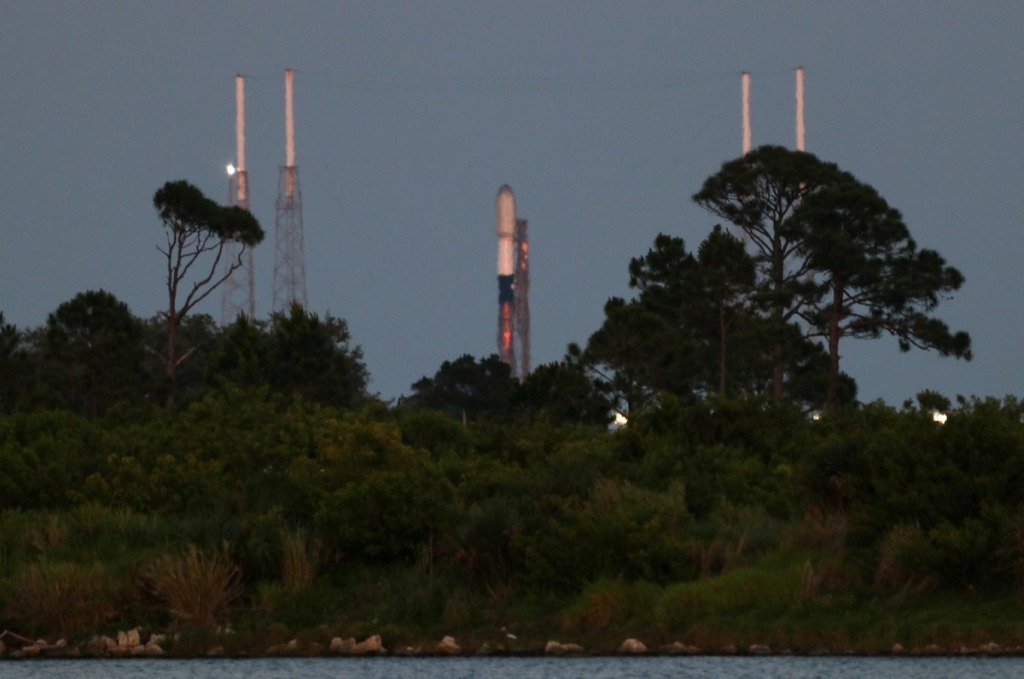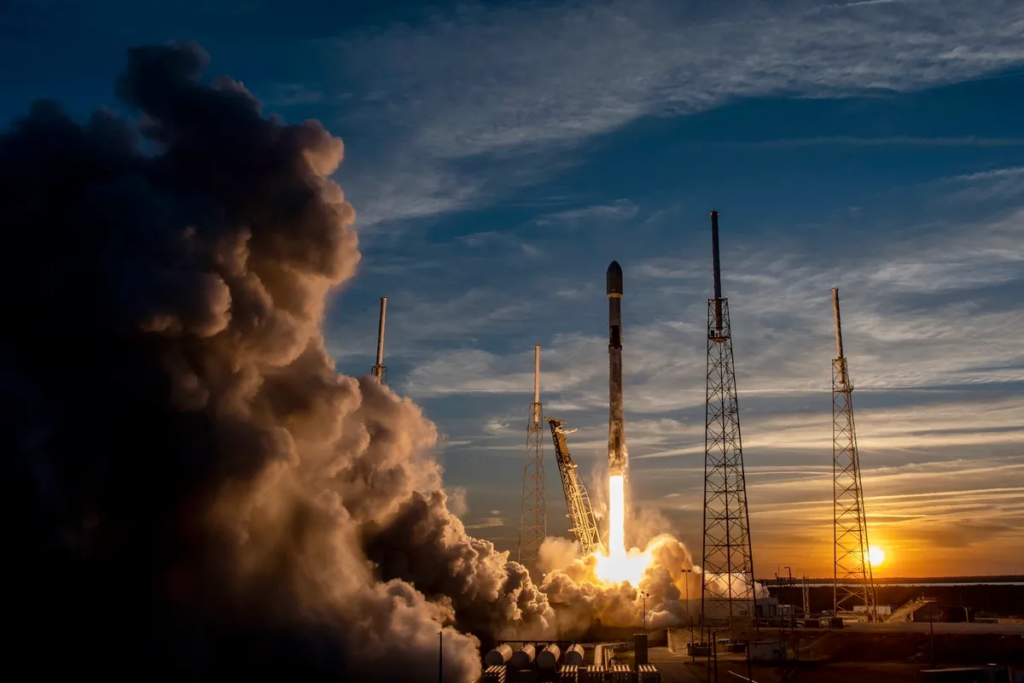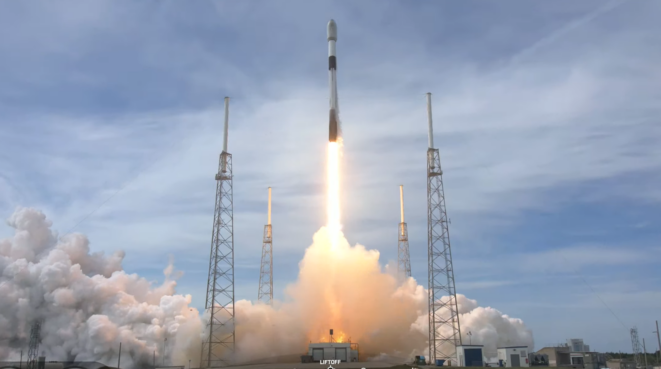SpaceX launched a Falcon 9 rocket and 56 spacecraft Thursday from Cape Canaveral, its fourth mission in less than a week, surpassing 4,000 Starlink broadband satellites in orbit.
Falcon 9 launched from Pad 40 at Cape Canaveral Space Force Station at 3:31 a.m. EDT (0731 UTC) Thursday. SpaceX launched its 30th rocket of the year before morning, keeping it on track for over 100 rocket launches in 2023, up from 61 last year.
SpaceX launched 56 Starlink satellites on Thursday, raising the total to 4,340.
According to Harvard-Smithsonian Center for Astrophysics astronomer Jonathan McDowell, SpaceX has more than 3,900 Starlink satellites in space, with nearly 3,400 operational and over 400 moving into operational orbits.

For the first time, SpaceX has more than 4,000 Starlink satellites in orbit, including Thursday’s 56 additional spacecraft, according to McDowell’s figures. After their missions or technical failures, SpaceX deactivated and de-orbited the remaining of its Starlink satellites.
After two launches earlier this year, Thursday’s mission deployed SpaceX’s Starlink V1.5 satellites. Starlink V2 Mini satellites are bigger and have four times the broadband bandwidth of prior satellites.
After launching on a Falcon 9 rocket on February 27, the first 21 Starlink V2 Mini satellites had issues. SpaceX has delayed the launch of certain Starlink V2 Mini satellites because some were de-orbited. McDowell’s website shows several Starlink V2 Minis moving throughout the constellation to start commercial internet service.
Starlink V2 Minis have improved phase array antennae and a more efficient, higher-thrust argon-fueled electric propulsion engine. Unlike Starlink V1.5 spacecraft, they feature two solar arrays.
The Starlink V1.5 satellites on Thursday’s Starlink 5-6 mission are identical to SpaceX’s previous Starlink spacecraft, but they entered an orbital plane that is, at least in legal terms, part of SpaceX’s Gen2 network.
In December, SpaceX started populating new orbital planes with older-design satellites until the bigger Starlink spacecraft design is ready to take over.
In February, SpaceX began flying Starlink V2 Mini satellites, an intermediary step between the smaller Starlink V1.5 spacecraft and the bigger Starlink V2s, which the firm expects to launch using its new Starship mega-rocket.
Starlink V2s can send signals to cell phones. SpaceX launched Gen2 satellites on Falcon 9 rockets and produced V2 Minis to fit on its launch vehicles while the Starship rocket was still in testing.
Starships can lift roughly 10 times more cargo than Falcon 9 rockets and have more satellite space.
SpaceX received authority Dec. 1 from the Federal Communications Commission to launch up to 7,500 of its 29,988-spacecraft Starlink Gen2 constellation, which will orbit differently from the original Starlink fleet. SpaceX’s Gen2 satellites were postponed by the regulator.
The FCC authorized SpaceX to launch the first 7,500 Starlink Gen2 satellites into orbits of 525, 530, and 535 kilometers, with inclinations of 53, 43, and 33 degrees, utilizing Ku-band and Ka-band frequencies. Thursday’s Starlink 5-6 mission targeted Starlink Gen2’s 43-degree orbit.
Since 2019, SpaceX has launched 4,400 first-generation Ka-band and Ku-band Starlink spacecraft with FCC approval. SpaceX is finishing the first-generation Starlink network.

Gen2 satellites might boost Starlink coverage in lower latitudes and relieve network load from rising consumer adoption. SpaceX claims over 1 million active users, largely families in places where fiber access is unstable, costly, or unavailable.
All seven continents now have broadband internet access from Starlink spaceships.
The first-generation Starlink network design contains satellites orbiting a few hundred miles above the equator at 97.6 degrees, 70 degrees, 53.2 degrees, and 53.0 degrees. After completing flights into the first 53-degree shell in 2021, SpaceX sent most Starlink satellites into Shell 4, at 53.2 degrees, last year.
SpaceX’s launch crew monitored Falcon 9 rocket and launch pad equipment at a launch control center south of Cape Canaveral Space Force Station on Thursday morning. At T-minus 35 minutes, SpaceX loaded Falcon 9 with super-chilled, densified kerosene and liquid oxygen.

The rocket also received helium pressurant in the final 30 minutes. The Falcon 9’s Merlin main engines underwent “chilldown” seven minutes before liftoff. Launch preparations included Falcon 9 guidance and range safety systems.
After liftoff, the Falcon 9 rocket vectored its 1.7 million pounds of thrust from nine Merlin engines southeast over the Atlantic Ocean. Two-and-a-half minutes after liftoff, the Falcon 9 rocket’s nine main engines shut down. Cold gas control thrusters and expanded titanium grid fins guided the booster stage back into the atmosphere after it separated from the Falcon 9’s upper stage.
The rocket landed on the drone ship “A Shortfall of Gravitas” around eight-and-a-half minutes after liftoff following two brake burns. SpaceX’s B1069 rocket made its seventh launch Thursday.
The Falcon 9’s second stage burn ejected its reusable payload fairing. Parachuted nose cone parts were recovered by a rescue ship in the Atlantic.
Thursday’s first stage landed as the Falcon 9’s second stage engine switched off to deploy the Starlink satellites to a preliminary parking orbit. Before payload separation, a 54-minute upper stage burn reshaped the orbit.
SpaceX’s 56 Redmond, Washington-built Starlink spacecraft separated from the Falcon 9 rocket 65 minutes after liftoff.

The Falcon 9’s guidance computer sent the satellites into an orbit at 43 degrees to the equator and between 185 and 211 miles (298-by-340 kilometers). After separation from the rocket, the 56 Starlink spacecraft will deploy solar arrays, activate automatically, and navigate into their operational orbit 329 miles (530 kilometers) above Earth using their krypton-fueled ion engines.
ROCKET: Falcon 9 (B1069.7)
PAYLOAD: 56 Starlink satellites (Starlink 5-6)
LAUNCH SITE: SLC-40, Cape Canaveral Space Force Station, Florida
LAUNCH DATE: May 4, 2023
LAUNCH TIME: 3:31:00 a.m. EDT (0731:00 GMT)
WEATHER FORECAST: 95% chance of acceptable weather; Low risk of upper level winds; Low risk of unfavorable conditions for booster recovery
BOOSTER RECOVERY: “A Shortfall of Gravitas” drone ship northeast of the Bahamas
LAUNCH AZIMUTH: Southeast
TARGET ORBIT: 185 miles by 211 miles (298 kilometers by 340 kilometers), 43.0 degrees inclination
LAUNCH TIMELINE:
- T+00:00: Liftoff
- T+01:12: Maximum aerodynamic pressure (Max-Q)
- T+02:28: First stage main engine cutoff (MECO)
- T+02:31: Stage Separation
- T+02:38: Second stage engine ignition (SES 1)
- T+02:46: Fairing jettison
- T+06:12: First stage entry burn ignition (three engines)
- T+06:32: First stage entry burn cutoff
- T+08:09: First stage landing burn ignition (one engine)
- T+08:30: First stage landing
- T+08:40: Second stage engine cutoff (SECO 1)
- T+54:03: Second stage engine ignition (SES 2)
- T+54:05: Second stage engine cutoff (SECO 2)
- T+1:04:51: Starlink satellite separation
MISSION STATS:
- 221st launch of a Falcon 9 rocket since 2010
- 232nd launch of Falcon rocket family since 2006
- 7th launch of Falcon 9 booster B1069
- 163rd flight of a reused Falcon booster
- 188th SpaceX launch from Florida’s Space Coast
- 123rd Falcon 9 launch from pad 40
- 178th launch overall from pad 40
- 82nd Falcon 9 launch primarily dedicated to Starlink network
- 27th Falcon 9 launch of 2023
- 30th launch by SpaceX in 2023
- 22nd orbital launch attempt based out of Cape Canaveral in 2023

